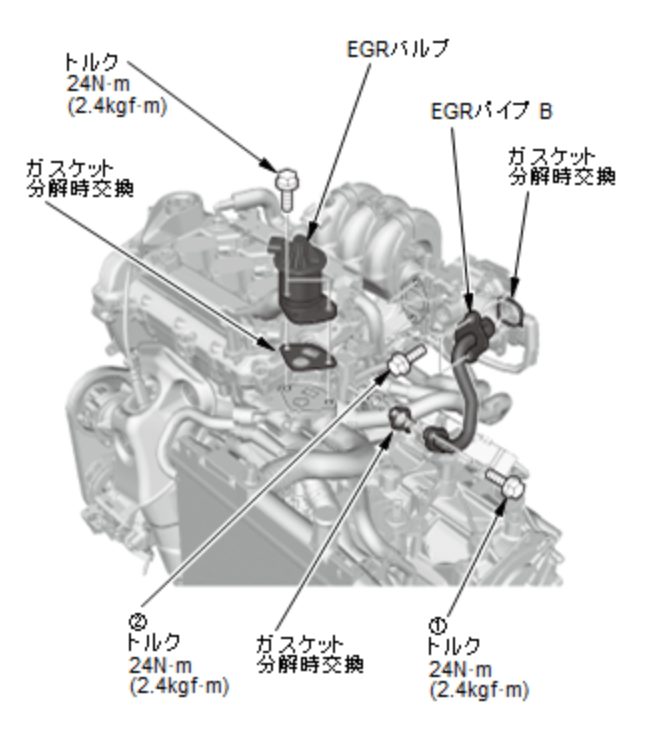
P2413 Exhaust Gas Recirculation Performance
Content
OBD-II Trouble Code - P2413 - Data Sheet
P2413 - Characteristics of the exhaust gas recirculation system.
What does trouble code P2413 mean?
This Diagnostic Trouble Code (DTC) is a generic transmission code, which means it applies to all vehicles since 1996 (Ford, Dodge, GMC, Chevrolet, Mercedes, VW, etc.). Although general in nature, the specific repair steps may differ depending on the brand / model.
A stored code P2413 means the powertrain control module (PCM) has detected a malfunction in the exhaust gas recirculation (EGR) system.
The exhaust gas recirculation system used in vehicles equipped with ODB-II is designed to reduce nitrogen oxide emissions in engine exhaust gases. It consists of an electronically controlled EGR valve that is opened by a voltage signal from the PCM. When it is open, some of the engine's exhaust gas can be re-circulated to the engine's intake system, where excess NOx vapor is burned as fuel.
There are two main types of EGR systems used in modern automobiles and light trucks. They are available in linear and vacuum diaphragms. Both types have multiple holes that intersect in the same chamber. One of the holes is equipped with a plunger that tightly closes it when there is no command to open. The valve is positioned so that when the plunger is opened, exhaust gases can pass through the EGR chamber and into the intake duct (s). This is usually achieved with an exhaust gas recirculation pipe or extended intake duct. Linear EGR is opened by one or more electronically controlled solenoids controlled by the PCM. When the PCM detects a certain engine load, vehicle speed, engine speed and engine temperature (depending on the vehicle manufacturer), the EGR valve opens to the desired degree.
A vacuum diaphragm valve can be a little tricky as it uses an electronically controlled solenoid to divert the intake vacuum to the EGR valve. The solenoid is usually supplied with suction vacuum at one (of the two) ports. When the PCM commands the solenoid to open, the vacuum flows through the EGR valve; opening the valve to the desired degree.
When the EGR valve is commanded to open, the PCM monitors the EGR system using several different methods. Some manufacturers equip their vehicles with a dedicated EGR sensor. The most common type of EGR sensor is the Delta Feedback Exhaust Gas Recirculation (DPFE) sensor. When the exhaust gas recirculation valve opens, the exhaust gases enter the sensor via high-temperature silicone hoses. Other automakers use changes in manifold air pressure (MAP) and manifold air temperature (MAT) to control the operation of the EGR system.
When the PCM commands the EGR valve to open, if it does not see the desired rate of change in the EGR sensor or MAP / MAT sensor, a P2413 code will be stored and the malfunction indicator lamp may illuminate.
Where is the P2413 sensor located?
Most EGR valves are located in the engine bay and are attached to the intake manifold. A tube connects the valve to the exhaust system.
Symptoms and severity
This is code related to emissions, which can be considered at your discretion. Symptoms of a P2413 code may include:
- Reduced fuel efficiency
- Presence of other related EGR codes
- Stored code
- Illuminated warning lamp of malfunction
- Engine running problems (eg, rough idle, lack of power, stalling, and surging)
- Reduced fuel consumption
- Increase in emissions
- Engine won't start
Causes of the P2413 code
Possible causes of this engine code include:
- Defective exhaust gas recirculation sensor
- Defective MAP / MAT sensor
- Bad EGR valve
- Exhaust leaks
- Cracked or broken vacuum lines
- Open or short circuit in the control circuit of the exhaust gas recirculation system or the exhaust gas recirculation sensor
- Faulty EGR valve
- EGR circuit problem
- Bad EGR position sensor
- Clogged EGR channels
- Exhaust leaks
- Problems with PCM
Diagnostic and repair procedures
A good starting point is always to check the Technical Service Bulletins (TSB) for your particular vehicle. Your problem may be a known issue with a known manufacturer-released fix and could save you time and money while troubleshooting.
To diagnose the P2413 code, you will need a diagnostic scanner, a digital volt / ohmmeter (DVOM), a hand vacuum pump (in some cases), and a vehicle service manual (or equivalent).
I usually like to start my diagnostic process by visually inspecting the wiring and connectors associated with the system. Repair or replace open or closed circuits as necessary.
Connect the scanner to the vehicle diagnostic socket and retrieve all stored DTCs and available freeze frame data. I like to write this information down because it can be of great help if it turns out to be intermittent code. Now clear the codes and test drive the vehicle to see if the P2413 is reset.
Be aware that it may take several drive cycles to clear this type of code. To determine that you have corrected a poor EGR performance condition, you need to allow the PCM to complete a self-test and enter OBD-II ready mode. If the PCM enters ready mode without clearing the code, the system operates as instructed. The vehicle is also prepared for emission testing in accordance with federal requirements when the PCM is in readiness mode.
If the code is cleared, consult your vehicle's service manual to determine which type of EGR is equipped with your vehicle.
To check the vacuum diaphragm valve for exhaust gas recirculation:
Connect the scanner to the diagnostic port and pull up the data stream. Narrowing down the data stream to display only relevant data will result in faster response times. Connect the hose of the hand vacuum pump to the vacuum port of the exhaust gas recirculation. Start the engine and let it idle with the transmission in park or neutral. While observing the corresponding readings on the scanner display, slowly turn on the hand vacuum pump. The engine should stall due to excessive activation of the exhaust gas recirculation at idle speed, and the corresponding sensor (s) should indicate the expected degree of deviation.
If the engine does not stall when the vacuum pump is down, suspect that you have a faulty EGR valve or clogged EGR passages. Clogged exhaust gas recirculation ducts are more common in high-mileage vehicles. You can remove the EGR valve and start the engine. If the engine makes a loud intake noise and stalls, the EGR valve is probably faulty. If the engine shows no change without the EGR system screwed on, the EGR passages are likely clogged. You can clean up carbon deposits from the EGR passages relatively easily on most vehicles.
The linear valves of the exhaust gas recirculation must be activated using the scanner, but the check of the exhaust gas recirculation channels is the same. Consult your vehicle's service manual and use the DVOM to check resistance levels in the EGR valve itself. If the valve is within specification, disconnect the appropriate controllers and test the system circuits for resistance and continuity.
Additional diagnostic notes:
- Failure of an exhaust gas recirculation valve is much less common than clogged ducts or faulty exhaust gas recirculation sensors.
- Systems designed to supply EGR gases to individual cylinders can contribute to misfire codes if the passages become clogged.
Codes related to P2413
- P0401 EGR Insufficient Flow Detected
- P0404 EGR control circuit range/performance
- P0406 EGR Valve Lift Sensor Circuit High Voltage
Need more help with your p2413 code?
If you still need help with DTC P2413, post a question in the comments below this article.
NOTE. This information is provided for informational purposes only. It is not intended to be used as a repair recommendation and we are not responsible for any action you take on any vehicle. All information on this site is protected by copyright.

2 comment
Leonard Vononi
Hello, I have a 70 cylinder Volvo v3 d5. I had the yellow engine light on and the error P1704 so I cleaned the Egr valve and replaced the intercooler sensor. Error p1704 no longer appeared but error P2413 appeared instead. I delete this error and turn off the engine but the next time the key is inserted the error reappears (it is not necessary to start the engine. Any advice? Thanks
Muresan Teodor
Hello, I'm the owner of an Audi a4 b7 2.0 tdi 2006 blb, since the egr valve was malfunctioning and after a while the engine light appeared and gave the code P2413, I read about this code, the question is if I can find a solution so that it doesn't come on anymore with the modification done thank you